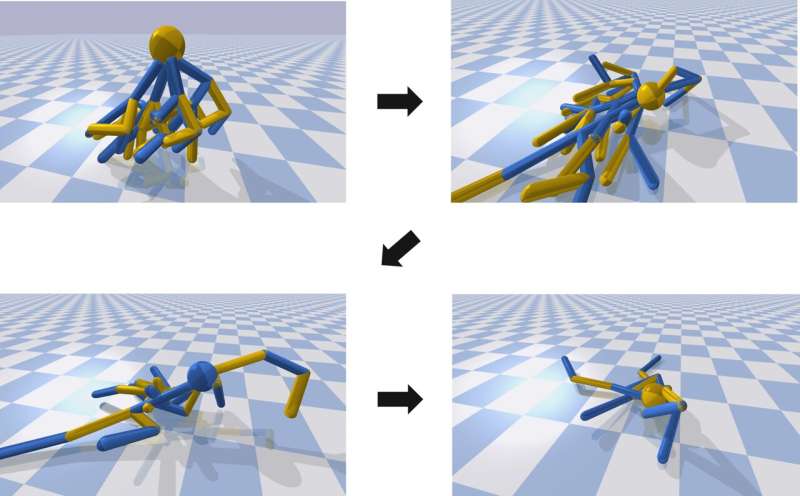The evolution of a robot from a sufficiently complicated morphology to one more suitable for walking. Credit: Koike et al.
Researchers at Kyoto University and Nagoya University in Japan have recently devised a new, automatic approach for designing robots that could simultaneously improve their shape, structure, movements, and controller components. This approach, presented in a paper published in Artificial Life and Robotics, draws inspiration from the evolution of vertebrates, the broad category of animals that possess a backbone or spinal column, which includes mammals, reptiles, birds, amphibians, and fishes.
"The automatic robot design is a completely novel research project for the Matsuno Lab, the laboratory led by Fumitoshi Matsuno, and this is the first paper published for this project," Ryosuke Koike, one of the researchers who carried out the study, told TechXplore. "Its primary objective was to design a good-performing robot for a given task. Since there are innumerable possible combinations of robot morphologies and controllers, it is impossible to reach the best robot by manual human exploration. Therefore, we realized that it is necessary to establish a method for automatically designing robots using computers."
Essentially, instead of developing a single robot design for a specific application, Koike and his colleagues wished to explore the possibility of creating a system that can automatically produce robot designs with specific morphologies and characteristics. If such a system worked efficiently, it could eventually simplify the development of task-specific robotic systems.
The most notable feature of the automatic robot design system is that it is partly inspired by the evolution of vertebrates. More specifically, Koike and his colleagues hypothesized that as they evolved over centuries, the number of bones in the bodies of vertebrates tended to decrease.
Their system follows a so-called "improvement rule" that is based on this hypothesis. More specifically, it was trained to design robots by removing unnecessary rigid parts from a previously developed complex robot. This in turn allows it to identify more effective morphologies and controller components for the newly designed robot.
"Current walking robots often have morphologies resembling vertebrates, such as dogs," Koike explained. "By mimicking the evolution of vertebrates, we might design robots with performance comparable to these practical robots. Furthermore, we hope that, ideally, morphologies that are more evolved than today's vertebrates will emerge and perform better."
Koike and his colleagues evaluated their automatic robot design method in a series of tests, where they compared it with other robotic design strategies. They found that the method's vertebrate evolution-inspired improvement rule led to the creation of simplified and yet interesting robot designs.
"The discrete factors of robot morphology—how many rigid parts a robot needs and how they should be connected—are difficult to handle theoretically, so they have largely depended on the designers' experience and intuitions," Koike said. "Or, in recent studies considering automatic robot design, they have often been explored in an almost exhaustive way. We made the search more efficient by setting a simple rule: monotonically reduce the number of rigid parts."
In the future, the automatic robot design method introduced by this team of researchers could be implemented in real-world settings to speed up and improve the design of robots. In addition, this work could inspire the development of other systems based on the save vertebrate evolution hypothesis.
In their next studies, Koike and his colleagues plan to explore the potential of other possible approaches for automatically designing robots, which will not necessarily be inspired by the evolution of vertebrate. In addition, they recently created an alternative method that tackles some of the limitations of their robot design approach, which will soon be presented in a new journal paper.
"So far, we only confirmed this method's effectiveness on walking tasks and found that it takes a long time to learn and only slightly outperforms existing methods," Koike added. "Humans invented the wheel to move efficiently across flat terrain. As the scope of robots' morphology expands, even the wheel should be invented automatically. If a better mechanism than the wheel exists, automatic robot design should even be able to invent it. Furthermore, as the scope of tasks expands, it should invent better aerial vehicles, ships, industrial robots, and so on."
More information: Ryosuke Koike et al, Automatic robot design inspired by evolution of vertebrates, Artificial Life and Robotics (2022). DOI: 10.1007/s10015-022-00793-4
© 2022 Science X Network























